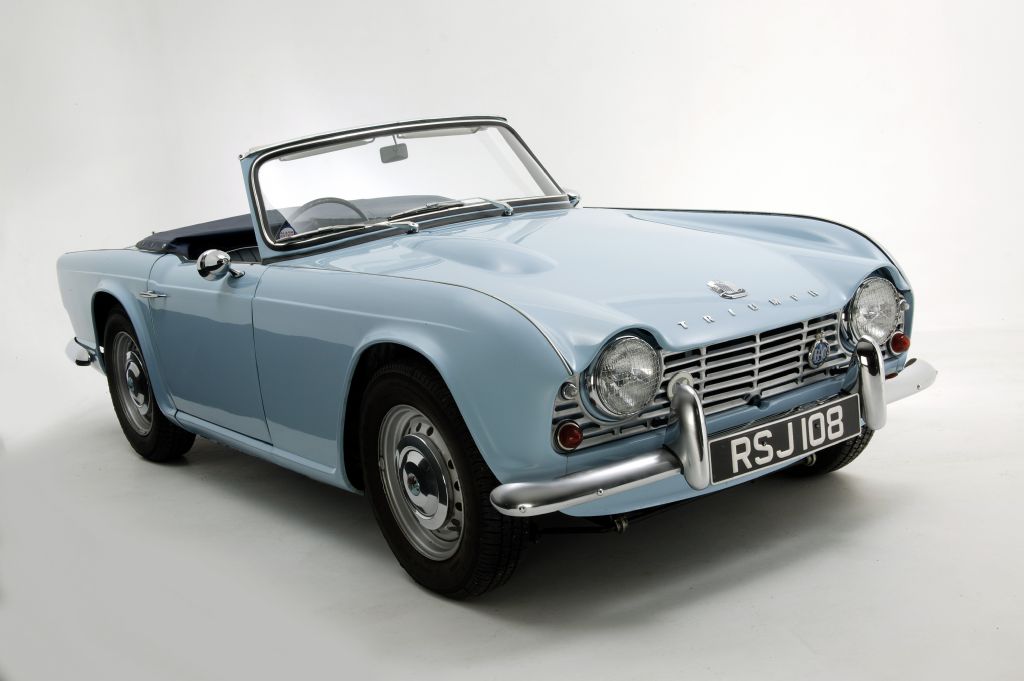Home > Classic Car Data > Triumph TR4
Triumph TR4
Intelligence Data:
About the Triumph TR4
The Triumph TR4 is a sports car produced by the British Triumph Motor Company from 1961 to 1965, the succeessor to the TR3A. Code named "Zest" during development, the car was based on the chassis and drivetrain of the previous TR sports cars, but with a modern Michelotti-styled body. During its production years 40,253 cars were built. The TR4 proved to be very successful.
The new TR4 body style did away with the cutaway door design of the previous TRs to allow for wind-down (roll-up) windows in place of less convenient side-curtains. The angular rear allowed a boot (trunk) with considerable capacity for a sports car.
Advanced features included the use of adjustable fascia ventilation, and the option of a unique hard top that consisted of a fixed glass rear window (called a backlight) with an integral rollbar and a detachable, steel centre panel (aluminium for the first 500 units). This was the first such roof system on a production car and preceded by five years the Porsche 911/912 Targa, which has since become a generic name for this style of top.
The pushrod Standard inline-four engine, was designed for use by the Fergusun TE20 tractor. The TR4 engine was continued from the earlier TR2/3 models, but the displacement was increased from 1991cc to 2138 cc in the TR4 by increasing bore size. Gradual improvements in the manifolds and cylinder head allowed for some improvements culminating in the TR4A model. The 1991 cc engine became a no-cost option for those cars destined to race in the under-two-litre classes of the day. Some cars were fitted with vane-type superchargers, as the three main bearing engine was prone to crankshaft failure if revved beyond 6,500 rpm; superchargers allowed a TR4 to produce much more horsepower and torque at relatively modest revolutions. The standard engine produced 105 bhp (78 kW) SAE but, supercharged and otherwise performance-tuned, a 2.2-litre I4 version could produce in excess of 200 bhp (150 kW) at the flywheel. The TR4, in common with its predecessors, was fitted with a wet-sleeve engine, so that for competition use the engine's cubic capacity could be changed by swapping the cylinder liners and pistons, allowing a competitor to race under different capacity rules (i.e. below or above 2 litres for example).
Other key improvements over the TR3 included a wider track front and rear, slightly larger standard engine displacement, full synchromesh on all forward gears, and rack and pinion steering. In addition, the optional Laycock de Normanville electrically operated overdrive could now be selected for second and third gears as well as fourth, effectively providing the TR4 with a seven-speed manual close ratio gearbox.
Steel box section chassis.
Transmission : 4-speed manual gearbox, optional overdrive, rear wheel drive.
Front suspension : Independent, coil springs.
Rear suspension : live axle, leaf springs.
Brakes : discs at the front and drums at the rear.
Vital Statistics
| Years: | 1961 to 1965 |
| Produced: | 40253 vehicles |
| Capacity: | 1991 cc |
| Engine: | Straight 4 OHV |
| Power: | 100bhp at 4,600 rpm |
| Top Speed: | 102 mph |
Source: Wikipedia
Search Database
Classified Alerts
We can help you find the classic vehicle you desire.
Advertise Here
You can advertise your business here. Call us on
01892 457670

